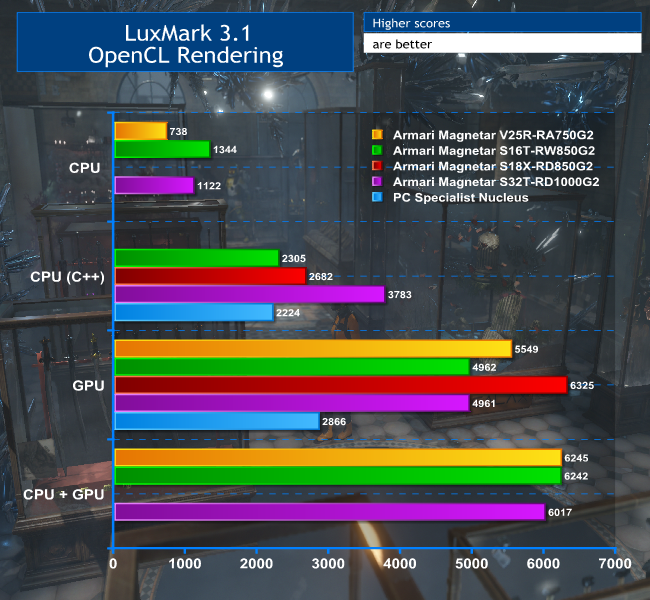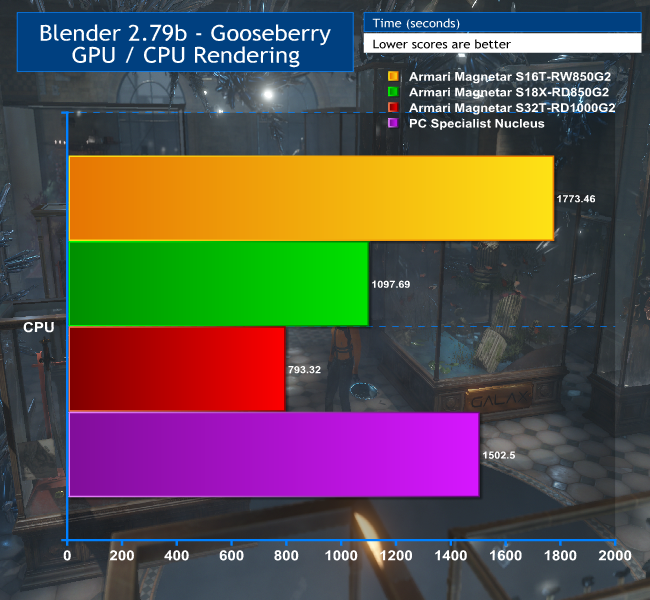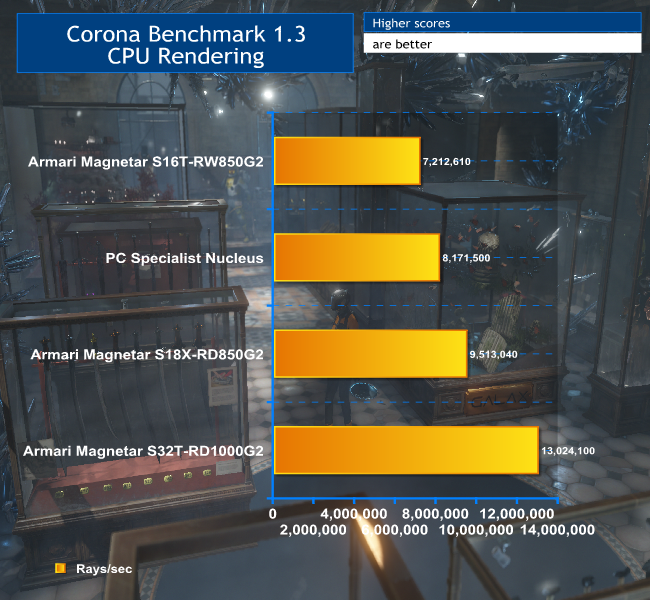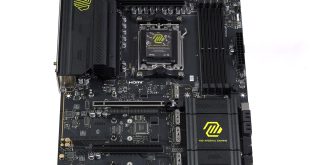LuxMark 3.1
OpenCL is a platform for harnessing GPU power for activities other than real-time 3D rendering to screen, also known as GPGPU. Unlike NVIDIA's CUDA platform, OpenCL is open source and can be ported to anything with processing power. So drivers are available for CPUs as well, both from Intel and AMD.
A popular tool for testing OpenCL performance is LuxMark. We haven't run this on many workstations before, so we only have one comparison amongst our past reviews. We ran the Sala scene on CPU only, GPU only, and then both.
Unfortunately, without AMD graphics installed you don't get OpenCL drivers for the CPU, so it's not possible to run the Threadripper 2990WX in OpenCL mode with LuxMark 3.1. But you can run the test in C++ mode, and the PNY NVIDIA Quadro P4000 graphics also has OpenCL support.
Surprisingly, the PC Specialist Nucleus gets a similar C++ CPU score as the Armari Magnetar S16T-RW850G2, which has a 16-core first-generation AMD Ryzen Threadripper 1950X. The Armari Magnetar S32T-RD1000G2 has the same processor, yet is 70 per cent faster overall.
The NVIDIA Quadro P4000 is way behind on OpenCL grunt as well compared to the other graphics cards, all of which are in at least the next price band up or even more.
LuxMark is a synthetic benchmark – it doesn't correspond directly to an application actually used in a production environment. It also uses OpenCL, the GPGPU API that is openly available to all hardware with drivers to run it.
But NVIDIA has its own proprietary GPGPU API called CUDA, which stands for Compute Unified Device Architecture. This name makes it sound as generally available as OpenCL, but in fact only NVIDIA graphics cards support it. There are a number of CUDA-enhanced 3D renderers out there, such as Octane Render, Redshift, and V-Ray.
The full list can be found on NVIDIA's website. But support for both CUDA and OpenCL is available in the latest version of the Open Source Blender, so let's turn to that application next.
Blender 2.79: Gooseberry Production Benchmark
Blender is a free and open source 3D creation suite. It supports the entirety of the 3D pipeline—modeling, rigging, animation, simulation, rendering, compositing and motion tracking, even video editing and game creation. The latest version at the time of writing, 2.79, supports rendering on the GPU as well as the CPU.
In GPU mode, it will render using OpenCL with AMD graphics cards, and CUDA with NVIDIA graphics cards. For this test, we used the Gooseberry Production Benchmark. Project Gooseberry is the code name for the Blender Institute's 6th open movie, Cosmos Laundromat — a 10-minute short, the pilot for the planned first-ever free/open source animated feature film. The benchmark renders a single frame from this film in intermediate quality.
Unfortunately, you need more than 8GB of graphics memory to run the Blender Gooseberry render on a GPU, which the PNY NVIDIA Quadro P4000 doesn't have. So we only include the CPU results here. However, whilst the PC Specialist Nucleus is 16 per cent faster than the 16-core Armari Magnetar S16T-RW850G2, it's actually 89 per cent slower than the Armari Magnetar S32T-RD1000G2. Again, we have a suspicion why this is but we will leave our theory to the conclusion of this review.
Corona 1.3 Benchmark
Corona Renderer is a new high-performance (un)biased photorealistic renderer, available for Autodesk 3ds Max and as a standalone CLI application, and in development for Maxon Cinema 4D.
The development of Corona Renderer started back in 2009 as a solo student project of Ondřej Karlík at Czech Technical University in Prague. Corona has since evolved to a full-time commercial project, after Ondřej established a company together with the former CG artist Adam Hotový, and Jaroslav Křivánek, associate professor and researcher at Charles University in Prague.
Despite its young age, Corona Renderer has become a production-ready renderer capable of creating high-quality results. The Corona Benchmark outputs a single ray-traced frame from a sample production.
The Corona Benchmark result tells the same story as Blender. The PC Specialist Nucleus is 13 per cent quicker than a 16-core AMD Ryzen Threadripper 1950X, but 16 per cent slower than the 18-core Intel Core i9-7980XE, and 59 per cent slower than the Armari Magnetar S32T-RD1000G2, which has exactly the same processor.
Overall, these are curious results for the PC Specialist Nucleus, which should be acing these well multi-threaded CPU rendering benchmarks. This hints at a configuration issue or lack of optimisation.
 KitGuru KitGuru.net – Tech News | Hardware News | Hardware Reviews | IOS | Mobile | Gaming | Graphics Cards
KitGuru KitGuru.net – Tech News | Hardware News | Hardware Reviews | IOS | Mobile | Gaming | Graphics Cards









